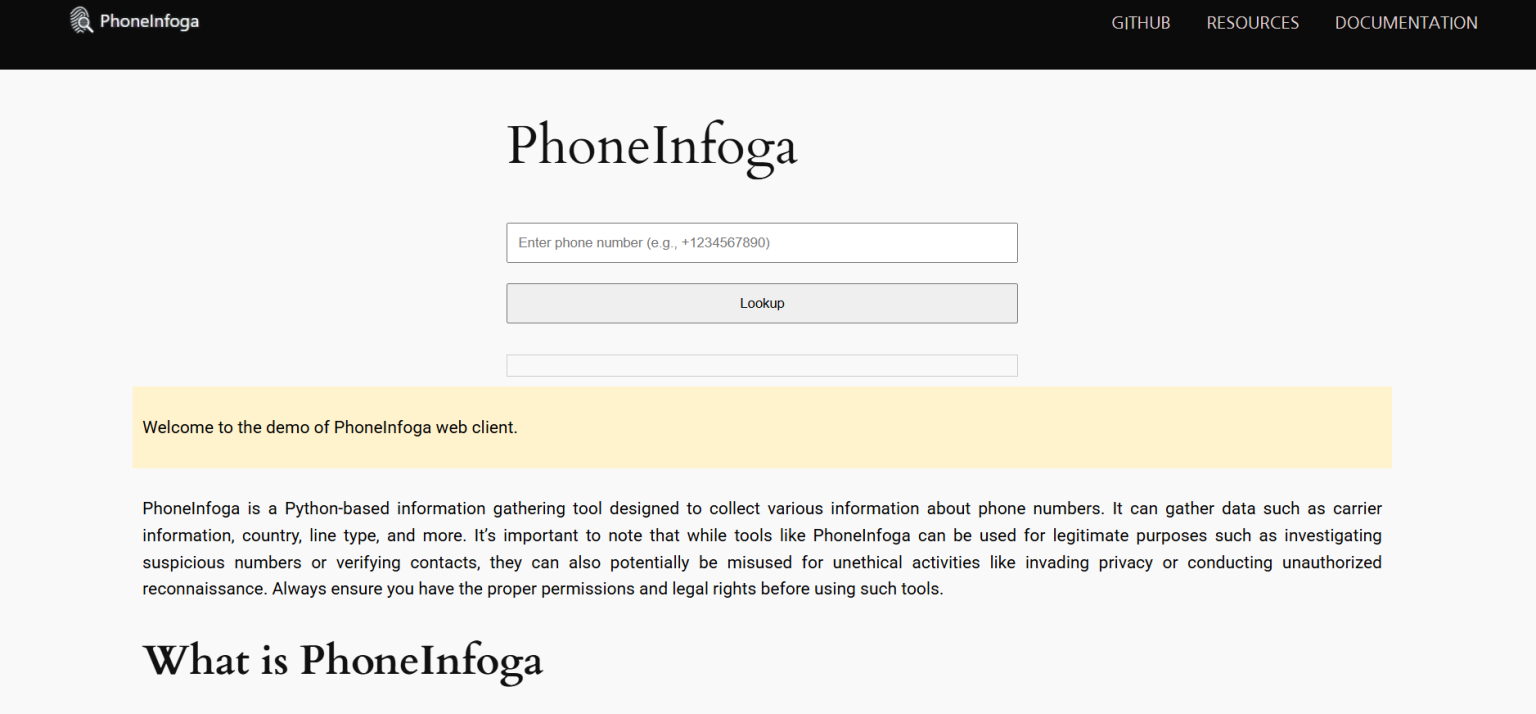Tracking unknown callers or verifying a suspicious phone number has become essential for cybersecurity experts, journalists, and even concerned individuals. Among the growing list of tools for digital investigations, PhoneInfoga stands out. But how fast and accurate is it when revealing a caller’s location?
This article explores PhoneInfoga’s capabilities, how it works, and whether it truly delivers fast results when pinpointing a caller’s geolocation. From use cases to performance tests, you’ll discover whether it’s the right tool for your needs.
PhoneInfoga Explained in Simple Terms
PhoneInfoga is an OSINT (Open Source Intelligence) tool that specializes in scanning and analyzing phone numbers. It’s open-source, widely used by security professionals, and offers the capability to gather a wide range of information, such as:
- Carrier or telecom provider
- Country and regional code
- Line type (mobile, landline, VOIP)
- Formatting verification
- External data scraping (e.g., social media mentions, dark web exposure)
The software doesn’t directly “track” someone like a GPS device might, but instead uses metadata and publicly available information to approximate a caller’s location or origin point. The keyword here is approximate.
How PhoneInfoga Performs a Lookup
Once a number is entered into the interface, PhoneInfoga kicks off a multi-layered search. Here’s a simplified breakdown of the steps:
Validation and Formatting
First, it checks whether the number is real and valid by comparing it against known numbering plans globally.
Carrier Identification
The tool identifies which telecom company owns the number. This helps narrow down its location, especially when paired with area codes.
Line Type Detection
Knowing whether a number belongs to a mobile phone, landline, or VOIP service adds more layers to its profile.
Geolocation Estimation
PhoneInfoga uses the carrier and number structure to guess the general location, often down to a city or region level.
Search for Digital Footprints
It queries multiple data sources, including HaveIBeenPwned, Google Search, and social networks, to discover where the number might have been used.
Real-Time Speed: How Fast Is It?
Speed depends on several factors: your internet connection, the number of external APIs configured, and the availability of online data. In a basic configuration:
- Local database checks (format, carrier, line type) take just a few seconds.
- Geolocation based on carrier and country code completes in under 10 seconds.
- External lookups like Google dorking or breach databases may take 30 seconds to a minute.
So yes, PhoneInfoga reveals caller location fast—if your goal is to get a rough location like country or city-level data. It’s not an instant GPS tracker, but for OSINT purposes, the turnaround time is impressively short.
Accuracy of Location Detection
The “location” PhoneInfoga returns is not always a pinpoint address. Instead, it might look like this:
- Country: United States
- Region: California
- Carrier: AT&T
- Line Type: Mobile
This can be enough for threat modeling or early investigations. But for precision tracking like pinpointing someone’s exact street, PhoneInfoga won’t deliver, and that’s by design. The goal is responsible, privacy-respecting reconnaissance.
In contrast, GPS tools or spyware apps may provide granular tracking, but they’re often illegal and unethical without consent.
Use Cases Where Location Matters
While PhoneInfoga isn’t designed to stalk individuals, it proves extremely useful in several legitimate and ethical scenarios:
Cybersecurity Incident Response
Suppose your organization receives repeated spam or threatening calls. Identifying whether the number is local or foreign helps with the mitigation strategy.
Investigative Journalism
Journalists can use PhoneInfoga to determine if a whistleblower’s number checks out before initiating sensitive contact.
Online Harassment Cases
Victims of cyberstalking or harassment can get a clearer picture of where the messages might be originating from.
Fraud Detection
Banks and fintech apps use OSINT tools like PhoneInfoga to flag potentially fraudulent numbers during onboarding or transactions.
Setup and Usage: Getting Started with PhoneInfoga
PhoneInfoga is available on GitHub and works on Linux, Windows, and macOS. You can run it via the command line or in Docker. Here’s a brief setup guide:
Install Prerequisites
You’ll need Python or Docker installed. If using Python:
bash
CopyEdit
git clone https://github.com/sundowndev/PhoneInfoga
cd PhoneInfoga
python3 -m pip install -r requirements.txt
Run a Basic Scan
bash
CopyEdit
python3 phoneinfoga.py -n +14155552671
This command starts the scan and prints results to your terminal.
Advanced Options
PhoneInfoga allows integration with custom APIs like Numverify and OVH for more detailed lookups. You can even write plugins to extend its functionality.
Limitations of the Tool
Despite its usefulness, PhoneInfoga isn’t perfect. Here are its main limitations:
- No GPS tracking: It cannot provide live tracking or precise addresses.
- Dependent on open data: If the number hasn’t appeared online, results will be sparse.
- Carrier info can be outdated: People port their numbers, so carrier data might not reflect the latest ownership.
- VOIP masking: Apps like Google Voice or WhatsApp can make tracing much harder.
In short, PhoneInfoga is a reconnaissance tool, not a surveillance system.
Ethical and Legal Considerations
Using PhoneInfoga must comply with local data privacy laws. It’s meant for legal investigative work, not for violating someone’s privacy. Misusing the tool could lead to serious consequences, including criminal charges in some jurisdictions.
Always ensure you have a valid reason for using it—whether you’re a journalist, security researcher, or organization protecting its assets.
Community and Development
Being open-source, PhoneInfoga benefits from an active community. Developers continually update it to adapt to changes in telecom structures, integrate more data sources, and patch security gaps.
If you’re technically inclined, you can even contribute to its development or fork your version with custom modules. The official repository on GitHub is maintained by sundowndev, and contributions are welcome.
PhoneInfoga vs. Other OSINT Tools
Several tools offer similar functions, but none package them quite like PhoneInfoga. Here’s a quick comparison:
| Tool | Carrier Info | Geolocation | Social Lookups | Fast Results |
| PhoneInfoga | ✅ Yes | ✅ Region | ✅ Yes | ✅ Fast |
| Truecaller | ✅ Yes | ❌ No | ✅ Yes | ✅ Fast |
| Numverify API | ✅ Yes | ✅ Region | ❌ No | ✅ Fast |
| Maltego | ✅ Yes | ✅ With Plugins | ✅ Extensive | ❌ Slower |
As shown, PhoneInfoga balances speed, accuracy, and extensibility better than most alternatives, especially when used in combination with other OSINT tools.
Final Verdict: Can It Reveal Location Fast?
Yes—PhoneInfoga can reveal a caller’s location quickly, but with important caveats. It gives a regional estimate (often down to the state or city) based on metadata and telecom records. For OSINT and security teams, this speed and detail are usually sufficient for an early-stage investigation.
If you’re looking for ethical, responsible geolocation analysis, PhoneInfoga offers an excellent balance of speed and privacy awareness.
Pro Tips for Maximizing Accuracy
- Enable External APIs: Services like Numverify or OVH offer richer data when integrated.
- Cross-reference Results: Use multiple sources to verify accuracy.
- Combine with Other OSINT Tools: Stack your research with tools like Sherlock (for social usernames) or HaveIBeenPwned.
- Stay Updated: Frequent GitHub updates improve speed and data quality.
Wrapping Up
PhoneInfoga is a fast, ethical, and surprisingly powerful tool. It may not offer pinpoint GPS precision, but for regional tracking and metadata analysis, it shines. If used within the bounds of legality and ethical investigation, PhoneInfoga is an indispensable asset for anyone who needs to quickly analyze unknown phone numbers.

